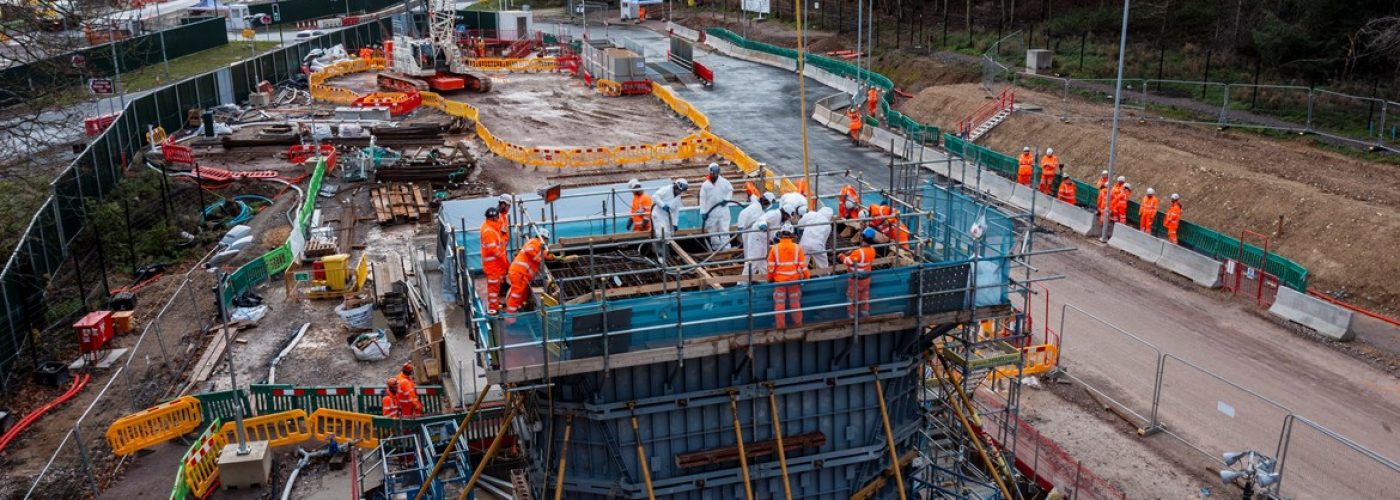The construction of the UK’s longest railway bridge took another major step forward this week with the start of work on the first of 56 giant concrete piers that will support the Colne Valley Viaduct as it crosses a series of lakes on the outskirts of London.
Stretching for 3.4km, the viaduct – being built as part of the HS2 rail project – will carry high speed trains travelling at speeds of up to 200mph between the outskirts of Hillingdon and the M25 on their way to Birmingham and the north.
The first pier was cast by engineers from HS2’s main works contractor Align JV – a team made up of Bouygues Travaux Publics, Sir Robert McAlpine, and VolkerFitzpatrick – and working in partnership with Kilnbridge.
Weighing in at around 370 tonnes, the 6m tall reinforced concrete pier was cast on site by a team of engineers who used a specially-designed formwork to create the shape of the structure. This was then removed after 4 days to reveal the final product.
Each pier is designed to support the full weight of the deck above and rests on a set of concrete piles going up to 55m into the ground. This foundation work began earlier this year and will require the construction of 292 piles and 56 pile caps across the whole length of the viaduct.
In another visible sign of progress on the project, the team have also completed the construction of the first of four jetties across the lakes to get equipment into position to support the construction thereby taking construction vehicles off local roads. Where the viaduct crosses the lake, the piles will be bored directly into the lakebed, using a cofferdam to hold back the water while the pier is constructed.
HS2 Ltd’s Project Client, David Emms, said:
“The Colne Valley Viaduct will be one of HS2’s most iconic structures and it’s great to see how much has been achieved already. I’d like to thank the whole team for the huge amount of work they’ve done to get us to this point.”
Align’s Project Director, Daniel Altier, added:
“I have no doubt that the viaduct will become one, if not the most striking element of HS2 phase 1 once complete. The way it will be constructed is going to be equally fascinating for engineers young and old. The sections for the deck will be fabricated at our main construction site to the west of London just inside the M25, and using a huge launching girder, the deck will be formed from north to south, along the line of the route, thereby keeping unnecessary construction traffic off the roads.
“I would like to thank the whole team, including our supply chain partners, who have worked very hard to enable us to meet this important milestone in the viaduct’s construction.”
The design of the Colne Valley Viaduct was inspired by the flight of a stone skipping across the water, with a series of elegant spans, some up to 80m long, carrying the railway around 10m above the surface of the lakes, River Colne and Grand Union Canal.
Set low into the landscape, wider spans will carry the viaduct crosses the lakes, and narrower spans for the approaches. This design was chosen to enable views across the landscape, minimise the viaduct’s footprint on the lakes and help complement views across the natural surroundings.
The main deck of the viaduct – which supports the railway line – will be built in 1000 separate unique segments at a temporary factory nearby before being assembled from north to south, starting next year.
As part of a push across the whole HS2 project to cut carbon in construction, the design and construction teams working on the viaduct have also cut the amount of embedded carbon in the viaduct by around a third, by narrowing the width of the structure and applying lessons for the design of highspeed railway bridges in Europe. Over the last six years, HS2 has worked closely with Affinity Water and the Environment Agency to monitor water quality and agree working methods. These are being monitored by a team of specialist engineers during construction in order to protect the natural environment.





